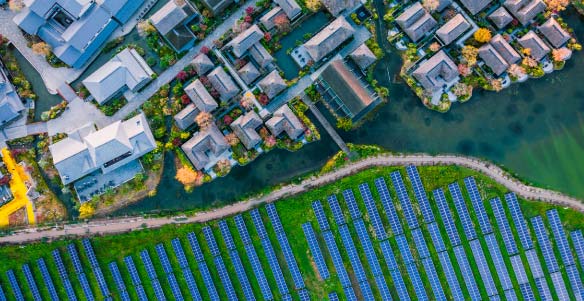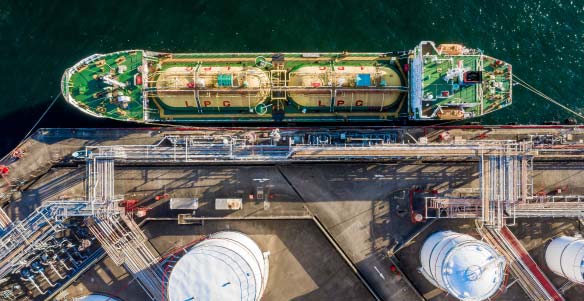The global energy system is in the throes of a generational shift.
Population and economic growth spell a demand for much more energy. Climate pressures spell an imperative for a different mix. And new technologies mean new opportunities for both.
Looking out a decade, to the mid-2030s, can that changing world of nearly 9 billion people power itself into a new age of sustainable growth? And where can Canada, a global leader in all forms of energy, create the most value in a Net Zero economy?
To map out the expected courses for both energy demand and supply in the 2030s, RBC Economics & Thought Leadership and RBC Capital Markets, including Global Research, developed global and national datasets, and new projections. The estimates are based on current assumptions of population growth, economic growth and distribution, technology adoption and government regulation.
The highlights of that research are laid out in this report, and its six major conclusions which are designed to help inform policy discussions at COP28, the UN Climate Conference in Dubai, and subsequent energy policy conversations.
We know energy is fundamental to every part of our economy, while our management of energy emissions is also fundamental to progress on climate change. Balancing those needs will require an informed public discussion, which this research is meant to contribute to.
1. The world will need to supply another United States worth of demand
Global population growth may be slowing, but the world still needs to generate more exajoules in the next few decades to power emerging economies’ growing needs. Global population is set to rise by 1.7 billion to 9.7 billion by 2050, adding the equivalent of another China and United States in one generation. More imminently, world population will rise by around 834 million by 2035, which is the equivalent of another Europe. That will require another 93 Quad BTU of energy, or close to what the United States consumes now.
When it comes to energy-intensity growth, the world appears to be on a two-track trajectory. In advanced economies, efficiency gains are lowering per capita consumption, which has contracted 13% over the past 20 years in Europe and North America, or about 0.7% per year. Population growth is also easing, but not declining outright in most advanced economies. Still, efficiency gains on a per-capita basis aren’t yet large enough for total energy demand to decline outright, even among advanced economies, especially in Canada.
Emerging markets are on a faster track and still in the early stages of adopting passenger vehicles, home appliances and advanced manufacturing. In India, the world’s most populous country, energy consumption rates are still relatively low. A slowing population growth rate will help contain emissions growth but not sufficiently enough to offset a growing demand for intensive energy sources, including coal. Indeed, India’s population growth remains concentrated in the north where coal-dependency remains significant for industrial and urban demands.
Global energy demand growth by region
Per-year percentage contribution to world energy consumption growth
Source: U.S. Department of Energy, RBC Economics
Elsewhere, the pace of growth is uneven across the developing world. Per-capita energy consumption rates in China, the world’s largest market, are approaching advanced economy levels and will begin to level out. The pace of energy demand growth is set to slow after rising by 2% per-year over the past decade. And decades of low birth rates from the one-child policy mean China’s population is outright declining, which (all else equal) lowers total energy demand. By our count, growth in total energy consumption will be half the pace of the last decade in China – with risks of further decline if its economy weakens.
The populous countries of Africa, rest of Asia and Latin America are facing their own unique challenges to build their economies while managing energy demand and climate pressures. Capital will be critical. Developing countries account for only one-fifth of investment in clean energy, despite making up two-thirds of the world’s population. Middle income countries, such as Brazil, Mexico and South Africa, are home to 75% of the global population and 62% of the world’s poor. Their rising disposable income, and aspirations to buy motorbikes, homes and electronics, will require all forms of energy.
Eventually, the massive gap between energy consumption rates in emerging markets will close as their economies mature — but we are not there yet.
Energy consumption per-capita
MMBtu/person, 2021
Source: U.S. Department of Energy, RBC Economics
2. Renewables will account for 20% of global energy needs
While total energy demand will continue to increase, a rising share will come from production of zero emissions and renewable power. Renewable power is set to grow at five times the rate of conventional energy by 2035, which would push the share of total energy consumption globally from renewables to about 20% from 12% in 2022 and 8% a decade earlier in 20121.
The cost competitiveness of renewables versus conventional energy has improved greatly, and government supports are encouraging a faster transition than otherwise would occur. Thanks to the Inflation Reduction Act, U.S. renewable energy growth is set to more than double by 2035, rising at a 7% per-year rate, or double the growth rate for renewables over the past decade.
In virtually all regions, renewable power is set to rise as a share of total energy consumption. One key reason: between 2010 and 2020, the cost of solar and wind power fell 56% and 85%, respectively. Much of that growth could displace coal and other high-emissions sources. Coal consumption outright declined by about 0.5% per year globally over the last decade, and is expected to decline annually at twice that pace through 2035. That would still leave coal accounting for about 20% of total global energy consumption in 2035, down from 27% currently and over 30% a decade ago.
Still, renewables are not without their challenges. Countries that have rolled out ambitious clean grid plans worry about the reliability of grids that depend primarily on wind and solar. A surge in installations is leading to cost inflation, at least in the medium term, while scaling up battery storage remains a challenge, although rapid advances are being made.
Global co-operation is also crucial to ensure a smoother roll-out of renewables and a level playing field across countries. The patchwork of global regulations, such as a carbon border adjustment tax, and different carbon pricing mechanisms, need further refinement, robust common standards, and general acceptance across jurisdictions to speed up the transition.
Political calculations could also change the trajectory of renewable adoption in many counties. There are signs of political resolve weakening on climate policies as the electorate around the world struggles with high cost of living, especially inflated energy bills. As many as 3.2 billion people in 40 countries (including the U.S.) with a combined GDP of US$44.2 trillion, will head to the polls in 2024. Climate policies are set to come under scrutiny and the prevailing public mood could well shift momentum in either direction.
Meanwhile, worries around China’s control over metals and minerals and technologies vital for the energy transition have led many countries to develop parallel, and costlier, supply chains. But new mines will take at least a decade to build and renewable supply chains could easily become more complicated and costlier in a trade-restricted world. While these frictions are unlikely to slow the pivot to renewables, they could delay it.
Global energy consumption by source
Source: U.S. Department of Energy, RBC Economics
3. Peak oil demand is coming—but not yet
Discussions around “peak oil” can miss the bigger picture: An industry can remain dominant for decades even if it never surpasses some past high point. We assume global oil demand will continue to slow as a share of total energy consumption, but volumes consumed will not outright peak before 2035.
Total petroleum consumption is already declining in major advanced economies (including the United States) but will continue to grow in emerging markets as population and energy use per person rises. There is substantial uncertainty around those estimates, with near-term risks both on the downside (slower global growth, notably in China) and on the upside (rapid technology adoption, also notably in China). Still, the direction of travel is clear: Over 60% of total global oil consumption is from the transportation sector, where the EV transition is well underway. China alone accounted for almost two-thirds of total global petroleum consumption growth over the last decade, and is now shifting rapidly to EVs. Full electric and plug-in hybrid vehicles have increased to 40% of total retail vehicle sales in China – more than 10 times the roughly 3% share in 2019.
Expected petroleum consumption growth by region
Per-year percent change, 2022 to 2035 (expected)
Source: UN, U.S. Department of Energy, RBC Economics
In Europe, electric vehicles already account for 44% of total car sales in 2022. The U.K. plans to fully end the sale of fully internal combustion engines by 2035. Canada plans to increase zero-emission vehicle sales to 60% of the new car market by 2030 and 100% by 2035. Those plans can change, and governments have a long history of delaying green energy objectives.
The turnover of vehicle fleets is another key factor. Internal combustion vehicles are staying on the road for longer than ever as reliability and durability improves (the average age of a vehicle in the U.S. is 12 years), suggesting a longer shelf life for existing stock even as EVs make up a greater share of sales. Still, per-capita petroleum consumption rates have already been declining for decades across advanced economies thanks to fuel efficiency increases, and that trend will likely accelerate as the market share of EV sales grows.
Per-capita petroleum consumption
Index = 100 in 2011
Source: UN, U.S. Department of Energy, RBC Economics
4. Natural gas faces a more uneven transition
The phasing down of coal power is expected to boost demand for natural gas as a transition fuel on an eventual pathway to renewables and battery storage—at least in advanced economies.
The pace of that transition will vary significantly by region, and with levels of government support. In the U.S., heat pump subsidies in the Inflation Reduction Act will help accelerate the transition to renewable fuels for home and commercial heating. Elsewhere, coal remains a core energy source, which gas could displace over time. China, the world’s largest emitter of greenhouse gases, is continuing to invest in nuclear power, but also permitted the equivalent of two large scale new coal power plants per week in 2022, despite pledges to reach Net Zero by 2060. In India, there is an estimated 65.3 GW of proposed, on-grid coal capacity under active development, equal to a third of its current coal generation capacity.
Globally, natural gas demand growth is expected to be driven primarily by increased demand in emerging markets — enough to ensure total demand for natural gas is not likely to peak until after 2035. But the pace of growth will average about half the 1.8% annual rate of growth over the last decade, and the share of natural gas in the total global energy mix will edge lower with renewable power sources growing more quickly.
In Canada, natural gas demand will be underpinned by strong demand from industrial sources – including high demand from the oil & gas sector. The expected launch of LNG Canada by mid-decade will signal Canada’s first major gas export foray beyond the United States, as major markets look for secure energy supplies. In Europe, since Russia’s invasion of Ukraine, plans for 26 new regasification terminals have been announced or launched, totalling 104.5 MTPA—a fifth of the current global LNG capacity, according to the International Gas Union. In Asia, Japan, China and South Korea remain among the world’s top three LNG importers. Their new long-term deals with multiple LNG exporters underscore their desire to secure and diversify energy supplies.
5. Oil Investments: Capturing value, capping emissions
Petroleum remains an important source of energy – still accounting for around 30% of total energy consumption by 2035. That would remain true even in the International Energy Agency’s more optimistic scenario in which global oil consumption peaks before the end of this decade. And the nature of Canadian oil production – heavily weighted to long-lived projects with very large initial sunk capital costs, and a relatively small share of global production – means that domestic oil production is relatively insensitive to near-term market dynamics2.
Canadian oil & gas capex spending still low
% of GDP
Source: Statistics Canada, RBC Economics
Still, the sector remains constrained by insufficient pipeline capacity to get Canadian production to market. The government-owned Trans Mountain Pipeline expansion will boost takeaway capacity significantly once it enters service likely in 2024. The 590,000-barrel-per-day expansion will fetch tidewater prices and reduce the discounts on Canadian benchmarks.
Additionally, oil sands production is well-capitalized and may not need significant further investments. As a result, total oil and gas investment has declined to 1.5% the size of annual Canadian GDP – less than half the share (3.7%) before the oil price collapse of 2015.
Even without new projects, the domestic industry can increase production over the next decade if global demand grows. We expect Canadian oil production to rise by 16.5% by 2030, primarily by increasing capacity of existing production rather than new investments.
The Federal government’s proposed framework for an oil & gas emissions cap could change that outlook. There is still no certainty of what that the final regulations will look like. The framework envisions a (soft) cap at 35%-38% below 2019 emissions from oil & gas production to be phased in from 2026 to 2030 and with options to produce above caps for a price. But details are still to come and will be influenced by feedback from industry, legislative pressures, and potential court challenges.
Decarbonization strategies may present the most significant capital need for oil and gas producers heading into the 2030s. The oil sector has already lowered emissions per barrel by roughly 20% since 2010, although increased production led to an absolute growth in emissions over that period. Plans and proposals for decarbonization projects, including carbon capture and sequestration, will require tens of billions of dollars of new capital, including from the federal and provincial governments. The sector believes such investments could secure its export markets for years, perhaps decades, to come.
6. Canada’s strong population growth will require a broad energy mix
Canada has one of the highest per-capita energy consumption rates in the world thanks to cold winters, hot summers, and a widely dispersed population. In addition, high levels of immigration are now the key driver of population growth, and added energy demand.
Will Canadians shift to climate-friendly technologies fast enough to offset the addition of five million newcomers over the next decade? The transition to EVs is one signal it might—the share of hybrid and full-electric vehicles in total autos sales has more than doubled over the last decade, to 16% from 7% a decade ago. And the volume of gasoline sales is running ~3% below 2019 levels despite a 6% population increase over that period.
Canadian gasoline sales growing slower than population
Index = 100 in 2019
Source: Statistics Canada, RBC Economics
The pandemic reset consumer behaviour with possibly long-term consequences. Work-from-home policies have also dented public transit traffic and fuel consumption. Plus, a new generation of Canadians, and younger immigrants, living in more urban settings, may further cut fuel consumption over time.
More people will likely mean more buildings to heat, too. Over the longer-run, alternative heat sources like heat pumps can help displace traditional natural gas and fuel oil as primary home heating sources. But cold winters mean energy demand for home heating will continue to grow and keep a floor under natural gas consumption—for now.
Canadian population growth bucking a slowing global trend
Average percent change per year
Source: UN population projections (Statistics Canada for Canada), RBC Economics
Canada’s share of renewable power is still relatively high (25%) compared to other countries, mainly due to the availability of abundant hydro power. But the impressive figure masks a weakness: Canada is one of the few advanced economies that failed to increase that share significantly over the past decade. That could change in the decade ahead with renewable power growth expected to accelerate, as envisioned in the proposed federal Clean Electricity Regulations. The rules aim to create low- or zero-emission electricity grids across Canada by 2035 and are part of the federal government’s overarching goal for the economy to get to Net Zero by 2050. The eventual shape and success of those regulations, which are opposed by several provinces, will be significant to the trend-line of natural gas consumption.
Canada is also expected to rely on growth in nuclear energy, led by Ontario, to boost the share of total energy consumption from the zero-emission source. As the industry regains acceptance as a reliable and safe zero-emissions energy source, we assume a 9% increase in nuclear energy consumption in Canada by 2035.
Canada energy consumption by source
Source: U.S. Department of Energy, RBC Economics
More broadly, the right policy levers and industrial innovation can transform Canada into an all-round global energy player, and taps its sun, wind and timber, in addition to its strategic fossil fuels. Canadian resources and ingenuity can be a force in the world and help us deliver our Net Zero target, as we stated in our $2 Trillion Transition report.
Related Reading
For more, go to RBC Economics & Thought Leadership.

Download the Report
Contributors:
Lead author: Nathan Janzen, Assistant Chief Economist, RBC Economics
Myha Truong-Regan, Head of Climate Research, RBC Climate Action Institute
Yadullah Hussain, Managing Editor, RBC Climate Action Institute
Caprice Biasoni, Graphic Design Specialist
- There is room for faster growth in renewable power if governments are more aggressive at accelerating the transition. IEA projections also have renewable power rising to ~20% of global energy consumption by 2035 based on ‘stated policies’, but the share rises to closer to a third in the more aspirational ‘announced pledges’ scenario.
- Oil production in Canada continued to grow through the global oil price collapse of 2015
This article is intended as general information only and is not to be relied upon as constituting legal, financial or other professional advice. The reader is solely liable for any use of the information contained in this document and Royal Bank of Canada (“RBC”) nor any of its affiliates nor any of their respective directors, officers, employees or agents shall be held responsible for any direct or indirect damages arising from the use of this document by the reader. A professional advisor should be consulted regarding your specific situation. Information presented is believed to be factual and up-to-date but we do not guarantee its accuracy and it should not be regarded as a complete analysis of the subjects discussed. All expressions of opinion reflect the judgment of the authors as of the date of publication and are subject to change. No endorsement of any third parties or their advice, opinions, information, products or services is expressly given or implied by Royal Bank of Canada or any of its affiliates. This document may contain forward-looking statements within the meaning of certain securities laws, which are subject to RBC’s caution regarding forward- looking statements. ESG (including climate) metrics, data and other information contained on this website are or may be based on assumptions, estimates and judgements. For cautionary statements relating to the information on this website, refer to the “Caution regarding forward-looking statements” and the “Important notice regarding this document” sections in our latest climate report or sustainability report, available at: https://www.rbc.com/community-social- impact/reporting-performance/index.html. Except as required by law, none of RBC nor any of its affiliates undertake to update any information in this document.





